Search Result
Results for "
Eicosapentaenoic Acid
" in MedChemExpress (MCE) Product Catalog:
2
Biochemical Assay Reagents
4
Isotope-Labeled Compounds
| Cat. No. |
Product Name |
Target |
Research Areas |
Chemical Structure |
-
- HY-B0660
-
|
EPA; Timnodonic Acid
|
Endogenous Metabolite
Histone Demethylase
|
Neurological Disease
Cancer
|
|
Eicosapentaenoic Acid (EPA) is an orally active Omega-3 long-chain polyunsaturated fatty acid (ω-3 LC-PUFA). Eicosapentaenoic Acid exhibits a DNA demethylating action that promotes the re-expression of the tumor suppressor gene CCAAT/enhancer-binding protein δ (C/EBPδ). Eicosapentaenoic Acid activates RAS/ERK/C/EBPβ pathway through H-Ras intron 1 CpG island demethylation in U937 leukemia cells. Eicosapentaenoic Acid can promote relaxation of vascular smooth muscle cells and vasodilation .
|
-

-
- HY-W011311
-
|
|
Others
|
Others
|
|
Eicosapentaenoic acid methyl ester is a degradant of a monogalactosyl diacylglycerol (an anticancer compound by inducing apoptosis) .
|
-
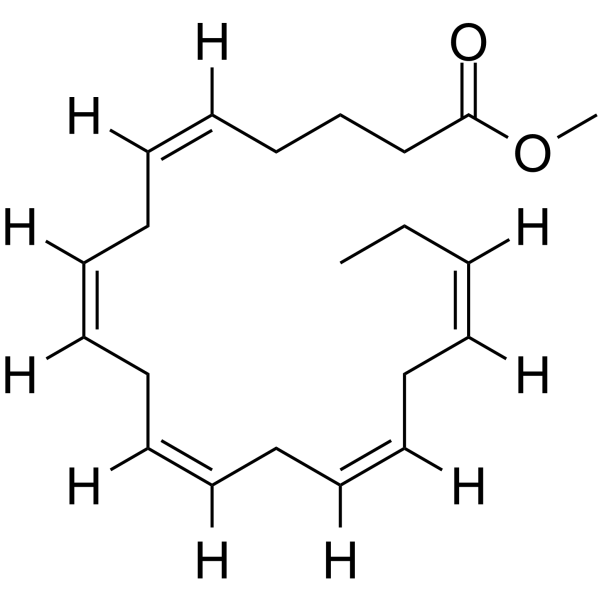
-
- HY-W011311R
-
|
|
Others
|
Others
|
|
Eicosapentaenoic acid methyl ester (Standard) is the analytical standard of Eicosapentaenoic acid methyl ester. This product is intended for research and analytical applications. Eicosapentaenoic acid methyl ester is a degradant of a monogalactosyl diacylglycerol (an anticancer compound by inducing apoptosis) .
|
-

-
- HY-B0747S
-
|
|
Endogenous Metabolite
|
Metabolic Disease
|
|
Eicosapentaenoic acid ethyl ester-d5 is the deuterium labeled Eicosapentaenoic acid ethyl ester. Eicosapentaenoic acid ethyl ester is an omega-3 fatty acid agent.
|
-
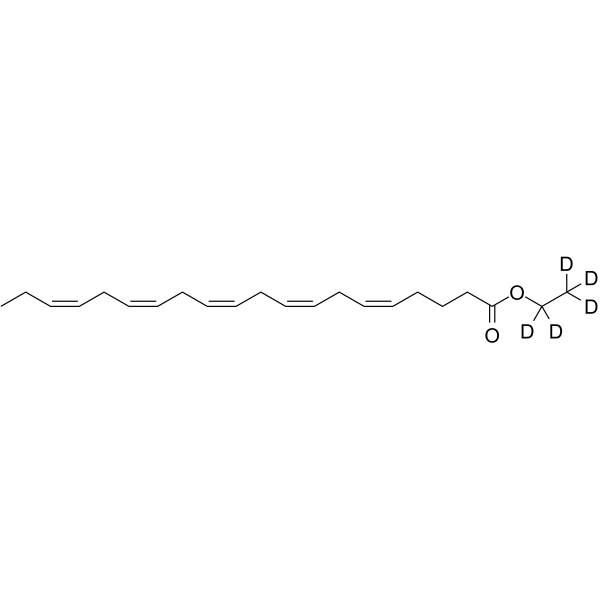
-
- HY-W011311S
-
|
|
Isotope-Labeled Compounds
Apoptosis
|
Others
|
|
Eicosapentaenoic acid methyl ester-d5 is the deuterium labeled Eicosapentaenoic acid methyl ester. Eicosapentaenoic acid methyl ester is a degradant of a monogalactosyl diacylglycerol (an anticancer compound by inducing apoptosis)[1].
|
-

-
- HY-W011269
-
|
EPA sodium; Timnodonic Acid sodium
|
Endogenous Metabolite
Histone Demethylase
|
Cardiovascular Disease
Metabolic Disease
|
|
Eicosapentaenoic Acid (EPA)sodium is an orally active Omega-3 long-chain polyunsaturated fatty acid (ω-3 LC-PUFA). Eicosapentaenoic Acid sodium exhibits a DNA demethylating action that promotes the re-expression of the tumor suppressor gene CCAAT/enhancer-binding protein δ (C/EBPδ). Eicosapentaenoic Acid sodium activates RAS/ERK/C/EBPβ pathway through H-Ras intron 1 CpG island demethylation in U937 leukemia cells. Eicosapentaenoic Acid sodium can promote relaxation of vascular smooth muscle cells and vasodilation .
|
-

-
- HY-127139
-
|
Eicosapentaenoic Acid Chloride; EPA Chloride
|
Endogenous Metabolite
|
Metabolic Disease
|
|
Eicosapentaenoyl chloride is a derivative of eicosapentaenoic acid. It has been used in the synthesis of fatty acid conjugates to enhance lipophilicity and cell permeability of bioactive compounds such as (–)-epigallocatechin gallate and salicylic acid.
|
-

-
- HY-B0747R
-
|
EPA ethyl ester(Standard); Ethyl eicosapentaenoate (Standard); AMR101 (Standard)
|
Endogenous Metabolite
|
Metabolic Disease
|
|
Eicosapentaenoic acid ethyl ester (Standard) is the analytical standard of Eicosapentaenoic acid ethyl ester. This product is intended for research and analytical applications. Eicosapentaenoic acid ethyl ester is an omega-3 fatty acid agent.
|
-
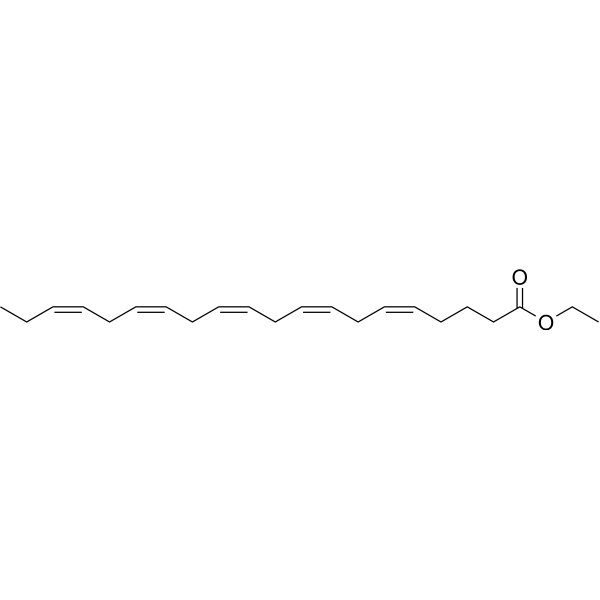
-
- HY-B0660S
-
-
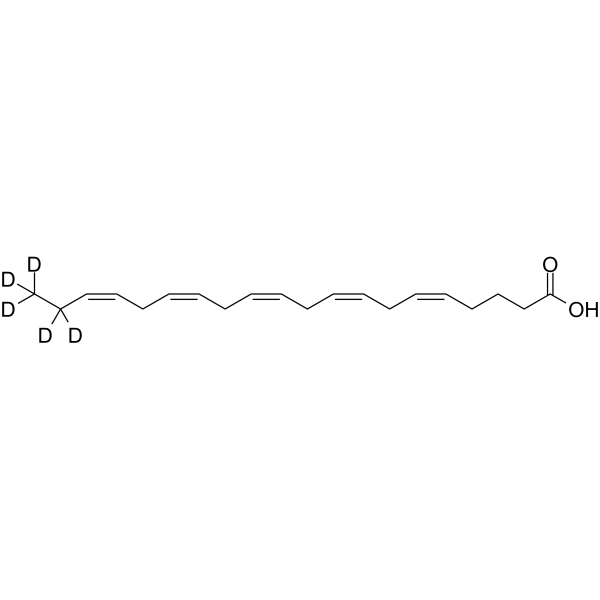
-
- HY-B0747
-
|
EPA ethyl ester; Ethyl eicosapentaenoate; AMR101
|
Endogenous Metabolite
|
Metabolic Disease
|
|
Eicosapentaenoic acid ethyl ester (EPA ethyl ester) is an orally active ω-3 fatty acid agent. Eicosapentaenoic acid ethyl ester could improve the activity of liver β-oxidase in vitro, reduce the level of liver total triglyceride, increase the content of liver triglyceride and phospholipid ω-3 fatty acid, and increase the total ω-3 fatty acid level in rats .
|
-

-
- HY-157910
-
|
|
Others
|
Metabolic Disease
|
|
(±)17(18)-EpETE methyl ester is an analog of the eicosapentaenoic acid (EPA) metabolite (±)17(18)-EpETE .
|
-

-
- HY-130319A
-
|
|
PPAR
|
Cardiovascular Disease
Metabolic Disease
|
|
9-HEPE, a oxidation product of Eicosapentaenoic acid, is a racemic mixture of 9(R)-HEPE and 9(S)-HEPE. 9-HEPE induces fatty acid oxidation, adipogenesis, and glucose uptake via activation of PPARs in vivo .
|
-
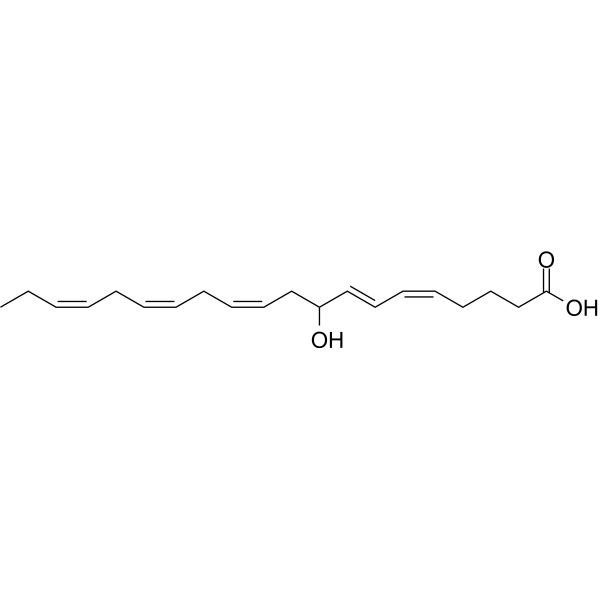
-
- HY-113120
-
|
6Z,9Z,12Z,15Z-Octadecatetraenoic Acid
|
Endogenous Metabolite
|
Others
|
|
Stearidonic acid (6Z,9Z,12Z,15Z-Octadecatetraenoic acid) is an intermediate fatty acid in the biosynthetic pathway from α-linolenic acid to VLC ω-3 PUFA. The conversion efficiency of stearidonic acid is higher than that of alpha-linolenic acid. Increasing the intake of stearidonic acid can increase the content of eicosapentaenoic acid (EPA) in red blood cells. Stearidonic acid can also be isolated from methanolic extracts of the brown alga Brachyphyllum gracilis .
|
-

-
- HY-130675A
-
|
15(S)-hydroxy-Eicosapentaenoic Acid; 15(S)-hydroxy EPA
|
Others
|
Inflammation/Immunology
|
|
15(S)-HEPE is a monohydroxy fatty acid. 15(S)-HEPE is biosynthesized from eicosapentaenoic acid by 15-lipoxygenase (15-LO). Serum levels of 15(S)-HEPE are elevated in patients with asthma.
|
-

-
- HY-130319
-
-
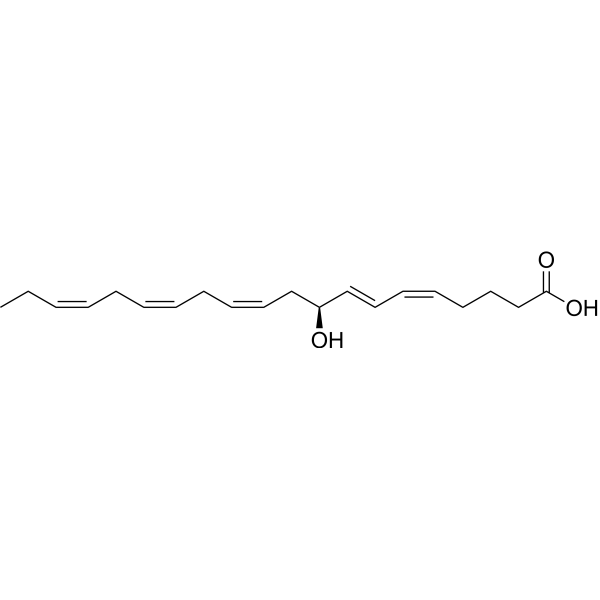
-
- HY-115421A
-
-
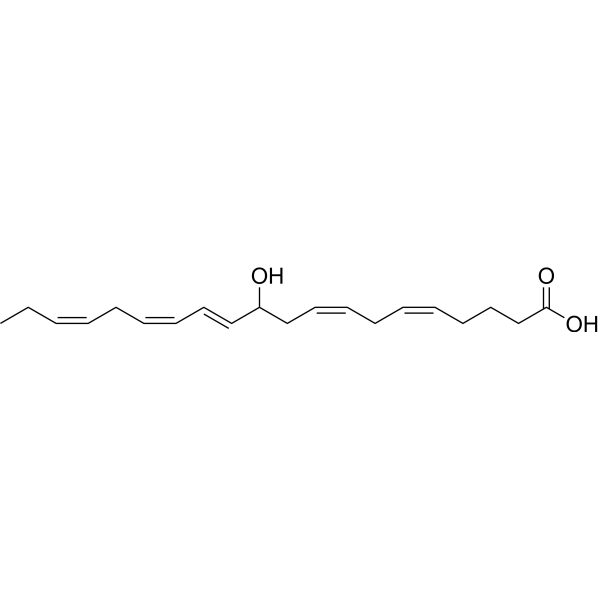
-
- HY-115421B
-
|
|
Others
|
Others
|
|
11(S)-HEPE is a monohydroxy fatty acid derived from EPA (eicosapentaenoic acid) .
|
-
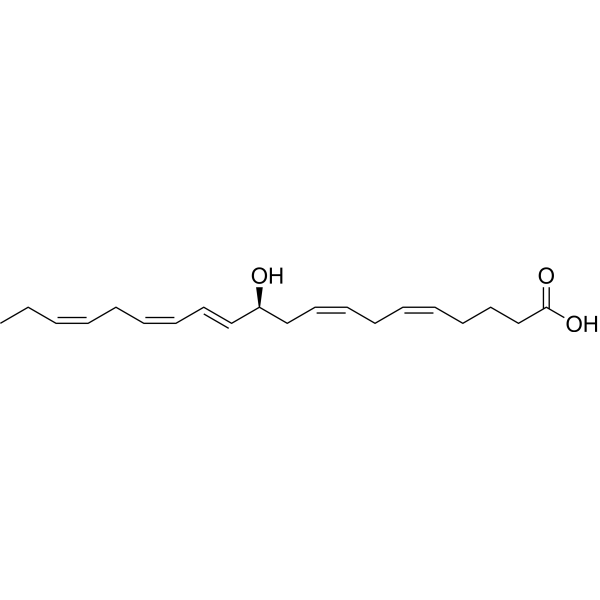
-
- HY-115421
-
-
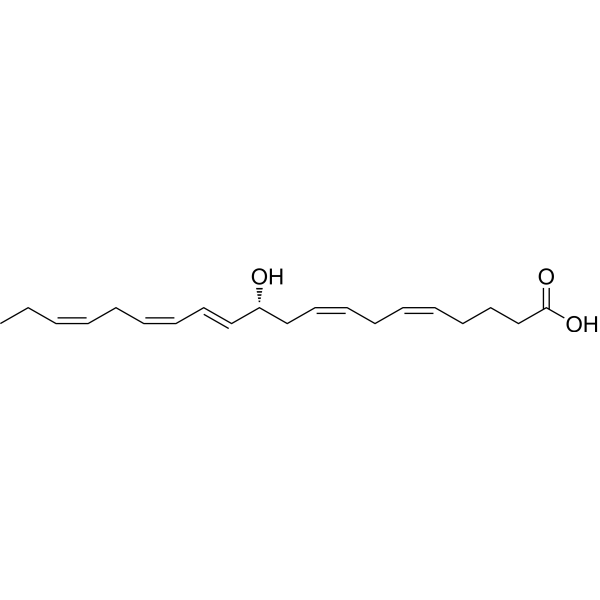
-
- HY-145522
-
|
MEM; 1,3-Myristin-2-Eicosapentaenoin; 14:0/20:5/14:0-TG
|
Others
|
Metabolic Disease
|
|
1,3-Dimyristoyl-2-eicosapentaenoyl glycerol (MEM) is a triacylglycerol that contains myristic acid (HY-N2041) at the sn-1 and sn-3 positions and eicosapentaenoic acid at the sn-2 position. The myristoyl groups in MEM do not affect the oxidative stability of eicosapentaenoic acid (EPA) during long-term storage at 25°C.
|
-

-
- HY-130138C
-
|
|
Calcium Channel
|
Inflammation/Immunology
|
|
5,6-DiHETE is an anti-inflammatory lipid mediator derived from eicosapentaenoic acid (EPA). 5,6-DiHETE has the ability to suppress vascular hyperpermeability during inflammation and is used in the research of inflammatory diseases .
|
-

-
- HY-113481
-
|
|
Others
|
Inflammation/Immunology
Cancer
|
|
Prostaglandin E3 is an eicosanoid derived from eicosapentaenoic acid. Prostaglandin E3 inhibits polarization towards M1 but promotes polarization of M2a macrophages. Prostaglandin E3 shows anti-inflammatory and anti-tumor activity .
|
-
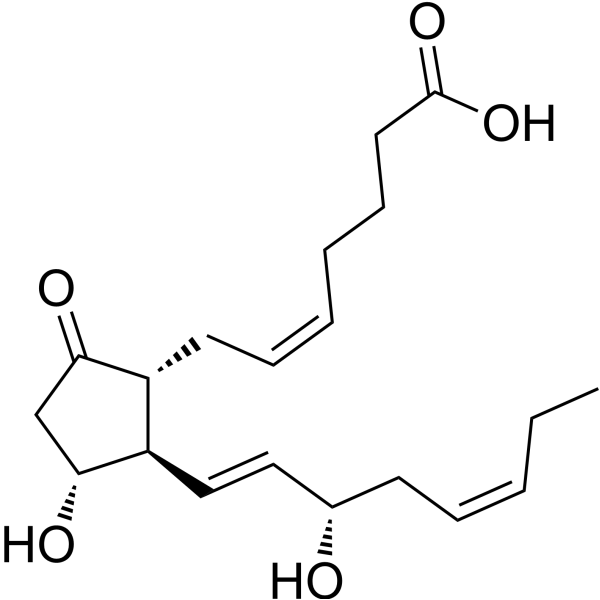
-
- HY-129764
-
|
PGF3α
|
Others
|
Metabolic Disease
Inflammation/Immunology
Cancer
|
|
Prostaglandin F3α (PGF3α) is an eicosapentaenoic acid (EPA)-derived bioactive lipid mediator that has anti-cancer and anti-inflammatory effects. Prostaglandin F3α is a substrate of ABCC4 with a Km of 12.1 μM. Prostaglandin F3α can be used for the research of diabetes .
|
-

-
- HY-115381
-
|
|
Endogenous Metabolite
|
Cardiovascular Disease
|
|
Lipoxin A5 is an eicosapentaenoic acid derived from pig white blood cells. Lipoxin A5 slowly contracted the guinea pig lung parenchymal strips with a contractile force similar to that of LXA4 and LXB4.2, but LXA5 did not have the vasodilating effect on the aortic smooth muscle shown by LXA4 and LXB4.2 .
|
-
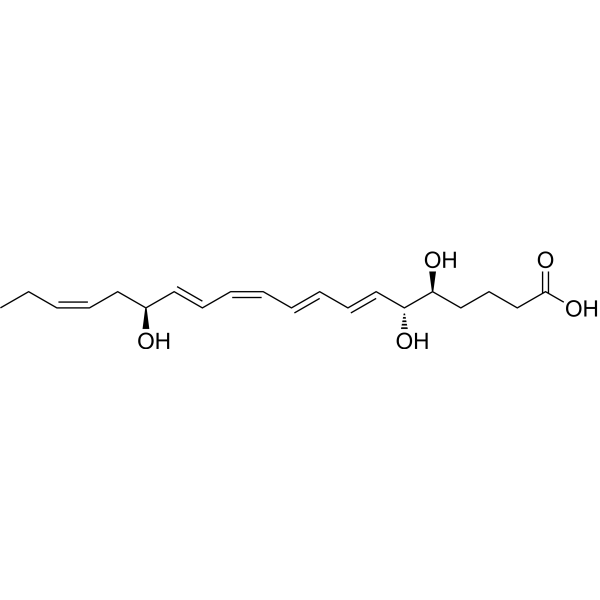
-
- HY-113445
-
|
|
COX
Endogenous Metabolite
|
Endocrinology
|
|
Thromboxane B3 is a prostaglandin analog derived from arachidonic acid (AA) in the cyclooxygenase (COX) metabolic pathway. Thromboxane B3 is generated from arachidonic acid (AA) in platelets and vascular endothelial cells through the catalysis of cyclooxygenase (COX) and thromboxane synthase (TXS). Thromboxane B3 has been reported to be formed by human platelets upon ingestion of eicosapentaenoic acid (C20: 5ω3) .
|
-

-
- HY-130309
-
|
(±)8,9-EEQ; (±)8,9-epoxy Eicosatetraenoic Acid
|
Angiotensin-converting Enzyme (ACE)
|
Cardiovascular Disease
|
|
Eicosapentaenoic acid (EPA) is converted to epoxyeicosatetraenoic acids (EpETEs) by several cytochrome P450 isoforms. The major product of this epoxygenase pathway, (±)17(18)-EpETE, relaxes vascular and airway smooth muscle by activating large conductance Ca 2+-activated K + (BKCa) channels by directly interacting with BKα channel subunits. (±)8(9)-EpETE is an epoxygenase pathway product produced from EPA by CYP450 both in vitro and in vivo.
|
-

-
- HY-120978
-
|
ω-3 Arachidonic Acid methyl ester; (all-Z)-8,11,14,17-Eicosatetraenoic Acid methyl ester
|
Biochemical Assay Reagents
|
Others
|
|
omega-3 Arachidonic Acid methyl ester, mainly docosahexaenoic acid, eicosapentaenoic acid and α-Linoleic acid, represented by linoleic acid, is an essential dietary nutrient required for normal growth and development.Omega-3Methyl arachidonic acid is a rare fatty acid Omega-3Neutral fat-soluble form of arachidonic acid. Omega-3Fatty acids, as a group, were associated with reduced inflammation and autoimmune activity, as well as reduced thrombosis and platelet activation.
|
-

-
- HY-113040A
-
|
17(R),18(S)-EETeTr
|
Calcium Channel
|
Cardiovascular Disease
|
|
(17R,18S)-Epoxyeicosatetraenoic acid (17(R),18(S)-EETeTr) is a cytochrome P450 epoxygenase metabolite of eicosapentaenoic acid (HY-B0660). (17R,18S)-Epoxyeicosatetraenoic acid shows exerts negative chronotropic effects and protects neonatal rat cardiomyocytes against Ca 2+ overload. (17R,18S)-Epoxyeicosatetraenoic acid has the potential for the research of antiarrhythmic agent .
|
-
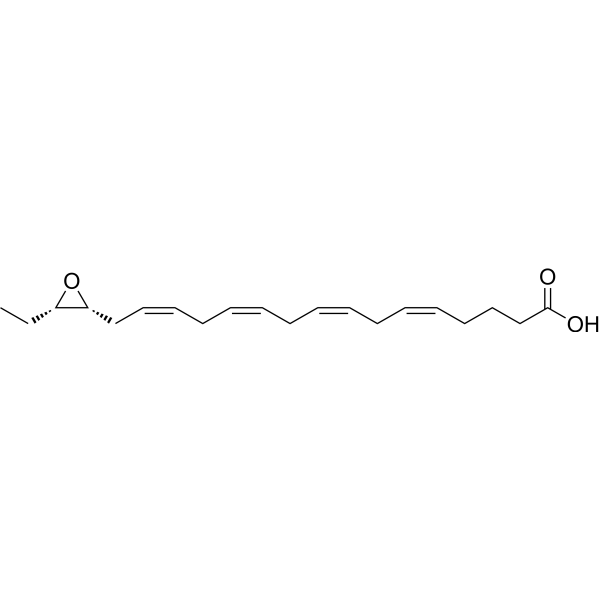
-
- HY-121888
-
|
|
Others
|
Metabolic Disease
|
|
20-HEPE is a metabolite of eicosapentaenoic acid formed by ω-oxidation of EPA by cytochrome P450 (CYP) ω-oxidases, including human CYP4F3B. At 10 μM, it activates peroxisome proliferator-activated receptor α (PPARα) in COS-7 cells expressing a luciferase reporter gene. 20-HEPE also activates mouse transient receptor potential vanilloid receptor 1 (mTRPV1) in vitro but lacks analgesic activity in rats.
|
-

-
- HY-114041
-
|
RvE1
|
Endogenous Metabolite
|
Inflammation/Immunology
|
|
Resolvin E1 (RvE1), a potent endogenous pro-resolving mediator of inflammation, is derived from omega-3 fatty acid eicosapentaenoic acid (EPA). Resolvin E1 is endogenously biosynthesized from EPA in the presence of Aspirin during the spontaneous resolution phase of acute inflammation, where specific cell-cell interactions occur. Resolvin E1 possesses unique counterregulatory actions that inhibit polymorphonuclear leukocyte (PMN) transendothelial migration. Resolvin E1 also acts as a potent inhibitor of leukocyte infiltration, dendritic cell migration, and IL-12 production .
|
-
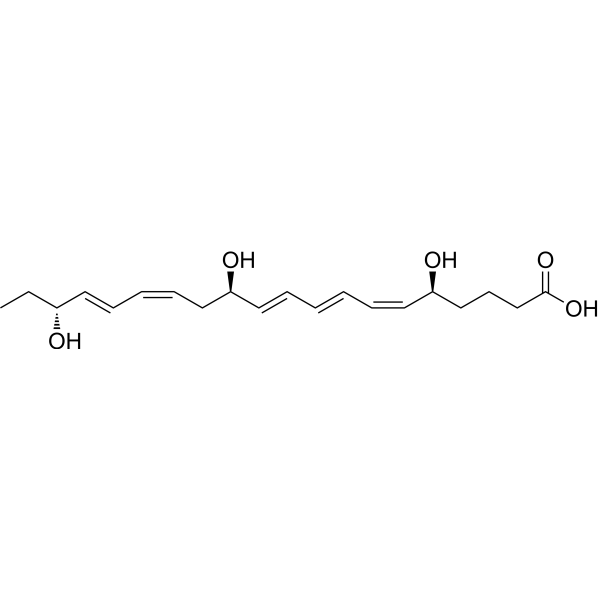
-
- HY-113484
-
|
LTB5
|
Others
|
Cancer
|
|
Leukotriene B5 (LTB5) is a leukotriene with diverse biological activities. It is a metabolite of eicosapentaenoic acid formed through the 5-lipoxygenase (5-LO) pathway. LTB5 increases contraction of bullfrog lung strips ex vivo in a concentration-dependent manner. In vivo, LTB5 (100 nM) reduces tumor volume in mice injected with Tm1 murine melanoma cells. LTB5 also elicits chemokinesis and lysosomal enzyme release from polymorphonuclear leukocytes (PMNLs) 20- to 30-fold less, and induces platelet aggregation 8-fold less, potently than LTB4.
|
-

-
- HY-118652
-
|
ω-3 6-keto PGF2α
|
Others
|
Metabolic Disease
|
|
Δ17-6-keto Prostaglandin F1α (Δ17-6-keto PGF1α) is a cyclooxygenase (COX) product of eicosapentaenoic acid (EPA) in various tissues such as seminal vesicles, lung, Polymorphonuclear leukocytes, and ocular tissues. Δ17-6-keto PGF1α and other 3-series COX products from EPA, such as PGF3α, PGE3, and thromboxane B3, may be involved in the reduced incidence of glaucoma in patients on a marine-rich (EPA-rich) diet.
|
-

-
- HY-N7833
-
|
HenEicosapentaenoic Acid
|
Biochemical Assay Reagents
|
Others
|
|
Heneicosapentaenoic Acid (HPA) is a 21:5 omega-3 fatty acid found in trace amounts in the green alga B. pennata and in fish oils. Its chemical composition is similar to eicosapentaenoic acid (EPA), except that a carbon is extended at the carboxy terminus, placing the first double bond at the δ6 position. HPA can be used to study the importance of double bond position in omega-3 fatty acids. It incorporates phospholipids and triacylglycerols in vivo with the same efficiency as EPA and docosahexaenoic acid, and exhibits a strong inhibitory effect on the synthesis of arachidonic acid from linoleic acid. HPA is a poor substrate for prostaglandin H synthase (PGHS) (cyclooxygenase) and 5-lipoxygenase, but retains the ability to rapidly inactivate PGHS.
|
-
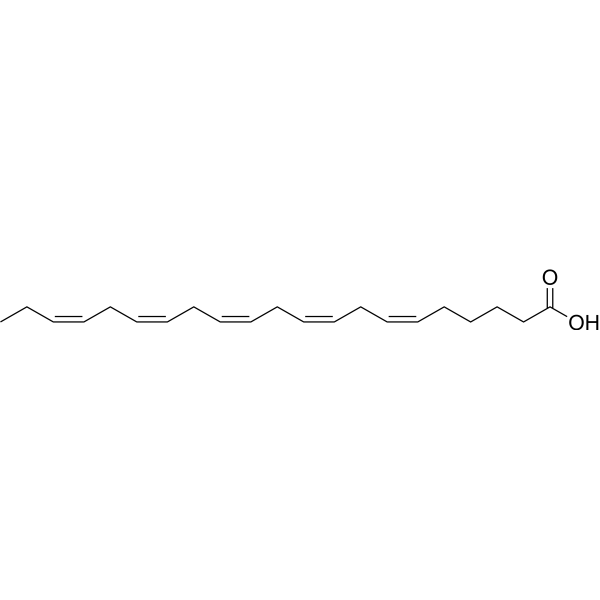
-
- HY-113513
-
|
|
Others
|
Cancer
|
|
5(S)-HEPE is an active metabolite of eicosapentaenoic acid. It is formed from EPA by 5-lipoxygenase (5-LO). 5(S)-HEPE is an agonist of G protein-coupled receptor 119 (GPR119). It increases cAMP accumulation in CHO-K1 cells expressing human GPR119 when used at a concentration of 10 μM. 5(S)-HEPE increases glucose-induced insulin secretion from MING6 insulinoma pancreatic islets and glucagon-like peptide 1 (GLP-1) secretion from HuTu 80 adenocarcinoma cells when used at a concentration of 10 μM. Serum levels of 5(S)-HEPE are elevated in patients with hyperlipidemia.
|
-

-
- HY-114041S1
-
|
RvE1-d4-1
|
Endogenous Metabolite
|
Inflammation/Immunology
|
|
Resolvin E1-d4-1 is the deuterium labeled Resolvin E1. Resolvin E1 (RvE1), a potent endogenous pro-resolving mediator of inflammation, is derived from omega-3 fatty acid eicosapentaenoic acid (EPA). Resolvin E1 is endogenously biosynthesized from EPA in the presence of Aspirin during the spontaneous resolution phase of acute inflammation, where specific cell-cell interactions occur. Resolvin E1 possesses unique counterregulatory actions that inhibit polymorphonuclear leukocyte (PMN) transendothelial migration. Resolvin E1 also acts as a potent inhibitor of leukocyte infiltration, dendritic cell migration, and IL-12 production[1][2].
|
-

| Cat. No. |
Product Name |
Type |
-
- HY-120978
-
|
ω-3 Arachidonic Acid methyl ester; (all-Z)-8,11,14,17-Eicosatetraenoic Acid methyl ester
|
Biochemical Assay Reagents
|
|
omega-3 Arachidonic Acid methyl ester, mainly docosahexaenoic acid, eicosapentaenoic acid and α-Linoleic acid, represented by linoleic acid, is an essential dietary nutrient required for normal growth and development.Omega-3Methyl arachidonic acid is a rare fatty acid Omega-3Neutral fat-soluble form of arachidonic acid. Omega-3Fatty acids, as a group, were associated with reduced inflammation and autoimmune activity, as well as reduced thrombosis and platelet activation.
|
-
- HY-N7833
-
|
HenEicosapentaenoic Acid
|
Biochemical Assay Reagents
|
|
Heneicosapentaenoic Acid (HPA) is a 21:5 omega-3 fatty acid found in trace amounts in the green alga B. pennata and in fish oils. Its chemical composition is similar to eicosapentaenoic acid (EPA), except that a carbon is extended at the carboxy terminus, placing the first double bond at the δ6 position. HPA can be used to study the importance of double bond position in omega-3 fatty acids. It incorporates phospholipids and triacylglycerols in vivo with the same efficiency as EPA and docosahexaenoic acid, and exhibits a strong inhibitory effect on the synthesis of arachidonic acid from linoleic acid. HPA is a poor substrate for prostaglandin H synthase (PGHS) (cyclooxygenase) and 5-lipoxygenase, but retains the ability to rapidly inactivate PGHS.
|
| Cat. No. |
Product Name |
Category |
Target |
Chemical Structure |
| Cat. No. |
Product Name |
Chemical Structure |
-
- HY-B0747S
-
|
|
|
Eicosapentaenoic acid ethyl ester-d5 is the deuterium labeled Eicosapentaenoic acid ethyl ester. Eicosapentaenoic acid ethyl ester is an omega-3 fatty acid agent.
|
-

-
- HY-W011311S
-
|
|
|
Eicosapentaenoic acid methyl ester-d5 is the deuterium labeled Eicosapentaenoic acid methyl ester. Eicosapentaenoic acid methyl ester is a degradant of a monogalactosyl diacylglycerol (an anticancer compound by inducing apoptosis)[1].
|
-

-
- HY-B0660S
-
|
|
|
Eicosapentaenoic Acid-d5 is the deuterium labeled Eicosapentaenoic Acid. Eicosapentaenoic Acid (EPA; Timnodonic acid) is an omega-3 fatty acid.
|
-

-
- HY-114041S1
-
|
|
|
Resolvin E1-d4-1 is the deuterium labeled Resolvin E1. Resolvin E1 (RvE1), a potent endogenous pro-resolving mediator of inflammation, is derived from omega-3 fatty acid eicosapentaenoic acid (EPA). Resolvin E1 is endogenously biosynthesized from EPA in the presence of Aspirin during the spontaneous resolution phase of acute inflammation, where specific cell-cell interactions occur. Resolvin E1 possesses unique counterregulatory actions that inhibit polymorphonuclear leukocyte (PMN) transendothelial migration. Resolvin E1 also acts as a potent inhibitor of leukocyte infiltration, dendritic cell migration, and IL-12 production[1][2].
|
-

Your information is safe with us. * Required Fields.
Inquiry Information
- Product Name:
- Cat. No.:
- Quantity:
- MCE Japan Authorized Agent:











































